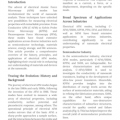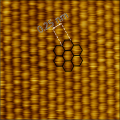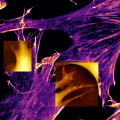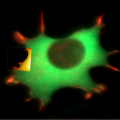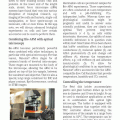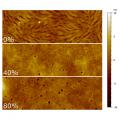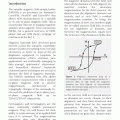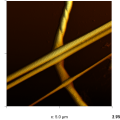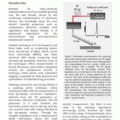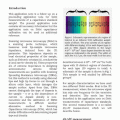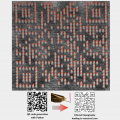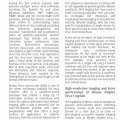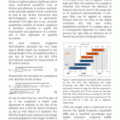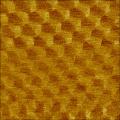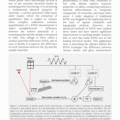Atomic force microscopy offers a multitude of different measurement modes that enables researchers to characterize the properties of any given samples, ranging from high resolution surface topography to electrical or magnetic properties. This page offers a brief overview of common AFM modes. To learn about each mode in more detail and see application, view the full article.
Contact Modes
Static Force Mode
Static mode, or contact mode, is the original and simplest mode to operate an AFM. In this mode, the probe is in continuous contact with the surface while the probe raster scans the sample. In other words, the probe "drags" across the sample and measures the mechanical contact force. The most common configuration of static mode is to operate it in constant force or deflection feedback mode. In this mode, the cantilever deflection is the feedback parameter. The cantilever deflection is set by the user and is related to how hard the tip pushes against the surface so that the user controls how gentle or aggressive the interaction between the probe and the sample is.
Lateral Force Mode
Lateral force mode or frictional force mode is a form of static mode (contact mode). In lateral force mode, the imaging is exactly as it is in static mode except the cantilever scanning motion is generally performed perpendicular to the axis of the cantilever, as opposed to a freedom of scan rotation for conventional static mode.
This mode is particularly effective for measuring the friction of a surface as the side to side twisting of the cantilever by torque, measured as the probe raster scans along the surface. Lateral force measurements can be converted to frictional force through calibration of the torsional spring constant of the cantilever.
Learn more about contact modes
Dynamic Modes
Dynamic Force Mode (Tapping Mode)
Dynamic force mode refers to a collection of AFM modes in which the cantilever oscillates at a high frequency at or close to resonance. A specific kind of dynamic mode, referred to as amplitude modulation mode (AM-AFM) is the most common AFM imaging mode. In AM-AFM, the amplitude of oscillation is the feedback parameter; other dynamic modes have different parameters for the feedback loop such as frequency (frequency modulation) or phase (phase modulation). Amplitude modulation mode, tapping mode, intermittent contact mode, and dynamic force mode can be used synonymously.
Phase Imaging Mode
Phase contrast imaging is one of the most common (if not the most common) AFM imaging methods to obtain contrast based on material properties. Phase contrast imaging is a form of dynamic mode, and refers to the phase channel that is collected during this mode. An excited cantilever oscillation will exhibit a phase shift (φ) between the drive and the response.
Learn more about dynamic modes
Off-resonance Tapping (ORT)
A special operation mode, referred to as off-resonance tapping (ORT) mode, oscillates the cantilever at frequencies well below the resonance frequency and was invented in 1997. It provides a fast, tuning-free, stable, and consistent imaging mode of surface topography in a mode of operation that is similar to force spectroscopy, albeit faster. The cantilever or sample is oscillated in a sinusoidal motion instead of the conventional triangular motion in spectroscopy. As a result, a trigger to stop the slope towards the sample as in spectroscopy cannot be used, and a more AFM-typical feedback loop is used, maintaining a constant, maximum interaction level of the oscillation. Because it is an off-resonance mode, no cantilever tuning to find a resonance peak is required. The modulation can be performed by a piezo, but this limits the maximum oscillation rate to typically less than 10kHz. By using photothermal ORT-excitation (PORT), this tapping rate can be further increased to rates above 100kHz. Depending on sample and scan size, PORT enables acquisition speeds in the two-digit line rate, translating to an acquisition time of under 30 seconds for a typical 256 x 256 pixel image using conventional cantilevers.
Scanning methods for advanced imaging modes
Additional measurement modes often in combination with special cantilevers enable the measurement of sample properties beyond the topography. Examples are Magnetic Force Microscopy (MFM) and several electrical AFM modes. Key in such measurements is to separate the short-range van der Waals forces from the longer range electrical or magnetic forces. A lifting mechanism enables the probing of longer range electrical and magnetic forces, and deconvoluting them from the short-range van der Waals forces that are present during topographic imaging.
Single pass method
In a single-pass or constant height setup, the slope of the surface is measured from a completed topography image or line before the imaging of the long range interaction is started, and then the tip is scanned at a fixed height above the sample, compensating for the average slope.
Dual pass method
Alternative to the single pass are the interlaced and dual pass imaging modes, providing the topographical information of the surface along with the functional signal. In interlaced mode the forward pass records the topography of a scan line and then the tip is lifted above the sample during the backward pass. In dual pass topography is measured forward and backward in the first pass and the long range signal in the forward and backward movement of the second pass. Dual scan provides the more accurate correlation between topography and long range signal, wheras the interlaced mode is faster.
Learn more about scanning methods for advanced imaging modes
Magnetic Force Microscopy
Magnetic force microscopy (MFM) is a phase imaging mode that uses atomic force microscope cantilevers with a thin magnetic coating in order to probe the magnetic field between a sample and a magnetized tip. This method is commonly used to image any materials with heterogeneous magnetic properties such as magnetic-based hard disk drives. It can be operated in single, interlaced and dual scan line modes. Any of these modes require optimization of the height above the sample at which the magnetic force microscopy image is collected.
Electrical AFM Modes
AFM can probe a wide variety of electrical properties of materials and surfaces. These methods operate either in static mode or dynamic mode, depending on the information being sought. Probing properties such as current, conductance, surface potential, and capacitance are increasingly important in a number of applications including research on semiconductors, solar and battery cells, conductive polymers, and nanoelectronics. These applications have in common that the electrical properties of increasingly miniaturized devices and features need to be measured.
Conductive AFM (C-AFM)
This is a static mode method where both the current distribution and topography of a surface are mapped simultaneously. It is similar to scanning tunneling microscopy as in both modes a bias voltage is applied between tip and sample, and the tunneling current is measured between the two. However, the advantage of C-AFM, which uses a conductive cantilever as opposed to a sharp metallic wire, is that it provides topography information and current information independently. Single point measurements that measure the current vs. voltage curves (commonly referred to as IV curves) can also be collected in this mode to probe the detailed electrical properties at a position.
Piezoelectric Force Microscopy (PFM)
This static mode based method is geared towards the study of ferroelectric or piezoelectric materials, which are materials that respond mechanically to the application of an electric field. This mode measures topography simultaneously with mechanical response of the material when an electric voltage is applied with a conductive AFM tip. A sharp conductive AFM tip is brought into contact with the sample and an AC voltage is applied between the tip and sample. The sample will either expand or contract oscillatory due to this applied voltage. The sample motion is then tracked by the cantilever deflection, which is detected with a lock-in amplifier. The amplitude gives information on the piezoelectric tensor of the material and the phase provides information on the polarization direction.
Electrostatic Force Microscopy (EFM)
This mode is the electrical equivalent to MFM and operates in phase imaging mode, but now used for imaging variations in the electric field of the substrate. When scanning the tip lifted above the surface (typically only a few tens of nanometers), a voltage is applied between tip and sample to create a long-range electrostatic force.
Kelvin Probe Force Microscopy (KPFM)
KPFM provides information on the contact potential or work function of a sample surface, thus providing a mechanism of contrast related to the sample electrical properties. Kelvin probe force microscopy operates in amplitude modulation mode, a type of dynamic force mode where a cantilever with a thin electrically conductive coating is driven at its resonance frequency (this mode is also referred to as tapping mode).
Force Spectroscopy
AFM Force spectroscopy refers to single point measurements in which the cantilever approaches and “pokes into” the sample, and then withdraws. During this measurement the cantilever deflection vs. piezo movement is measured, and this can ultimately be converted to a force vs. tip sample separation measurement that provides mechanical information about the sample. AFM Force curves can be mined for various mechanical properties of the sample including adhesion forces, stiffness (modulus), unfolding/stretching measurements, and indentation depth (how much the tip penetrates into the sample at a given load).
Learn more about force spectroscopy
Electrochemical AFM (EC-AFM)
Electrochemical AFM mode allows for AFM measurements while the electrochemical reaction is taking place. The AFM itself is not part of the electrochemical reaction, it only acts as an observer. In particular the AFM tip is not conducting and on floating potential to ensure it does not interfere with the electrochemical reaction. With a special electrochemical cell changes on the electrode surface can be monitored in an electrolyte solution. Both the reduction reactions at the cathode and the oxidation reactions at the anode can be studied. Knowledge of these reactions is crucial in applications such as corrosion, batteries and photovoltaics. Thus EC-AFM allows in-situ monitoring of the electrode structure during such reactions. As a result, the relation between the electrode structure / morphology and its electrochemical activity can be established.


